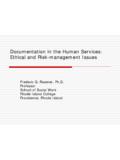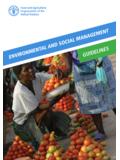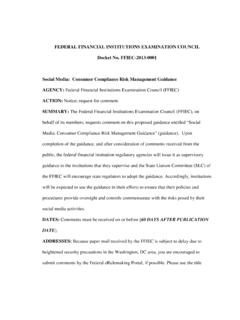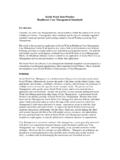Transcription of SOCIAL RISK MANAGEMENT - World Bank
1 SOCIAL RISKMANAGEMENTTHE World BANK S APPROACHTO SOCIAL PROTECTION IN A GLOBALIZING WORLDTHE HUMAN DEVELOPMENT NETWORKTHE World BANKS ocial Risk MANAGEMENT :The World Bank s Approach to SOCIAL Protection in a Globalizing WorldRobert Holzmann, Lynne Sherburne-Benz, and Emil TesliucSocial Protection DepartmentThe World BankWashington, 2003 AbstractSocial protection is moving up on the development agenda. Dis-missed as ineffective, expensive or even detrimental to developmentin developing countries for a long time, it is now increasingly under-stood that assisting individuals, households and communities indealing with diverse risks is needed for accelerated poverty reduc-tion, and sustained economic and SOCIAL development. Conceptu-ally, SOCIAL protection is shifting towards SOCIAL risk MANAGEMENT toreduce the economic vulnerability of households with appropriateinstruments and to help them smooth consumption patterns.
2 Forthe poor countries, it is about moving away from unproductivecoping strategies adopted by households (such as removing childrenfrom schools, delaying health care, selling livestock) that are buf-feted by shocks (such as drought, cyclones, floods, conflict, terms oftrade, policy reforms, health, unemployment, etc.). It seeks toreplace these strategies with ex-ante planning and mechanisms tohelp households anticipate and insure against these shocks (throughpublic works, weather-based insurance, water MANAGEMENT , grainstorage, micro-savings, etc.). For all countries, it is about rethinkingthe design and implementation of traditional public interventionssuch as labor market, SOCIAL insurance, and SOCIAL assistance paper outlines the development aspect of SOCIAL protection,presents the SOCIAL risk MANAGEMENT concept and its operationaliza-tion in risk and vulnerability assessments, explains the focus onvulnerable groups (such as children and the disabled), and brieflyreviews traditional programs such as labor market interventions andpensions through the SOCIAL risk MANAGEMENT IntroductionSocial protection (SP)
3 Is moving up on the development as ineffective, expensive or even detrimental to develop-ment in developing countries, it is now increasingly understood thatassisting individuals, households and communities in dealing withdiverse risks is needed for accelerated poverty reduction and sus-tained economic and human development. But, to be efficient in adeveloping country context providing the needed security in themost cost effective manner requires a different and fresh look at theprograms and instruments. Simply copying publicly provided andfinanced programs from rich countries will not do the trick in manycases. It requires a more comprehensive approach which draws atten-tion to many more risks , and which proposes many more instrumentsof dealing with diverse risks , than traditionally considered by socialprotection. This is the purpose of the SOCIAL risk MANAGEMENT (SRM)approach and its application in developing contribution outlines the World Bank s approach to socialprotection in a globalizing World , with a special focus on low incomecountries, where the vast majority of the population is outside theformal sector, and a major share lives below the poverty linehowever meagerly defined.
4 The paper starts out by putting the roleof SP and SRM within the current development debate, and dis-cusses the changes that have taken place over the last decade or so(Section 1). The focus on poverty within the development debatehas led to a better understanding of the poverty dynamics. It rec-ognizes the fact that there is a major mobility in and out of poverty,and thus concentrating on the (ex post) poor instead of the (ex-ante) vulnerable may be less effective (Section 2). The focus on vul-nerability is also the suggested approach to operationalize the SRMconcept, and to this end risk and vulnerability assessments are beingpiloted with great success in developing countries (Section 3). TheSRM lenses suggest looking at (very) vulnerable groups as a prom-ising approach to reduce vulnerability to poverty in countries withan incomplete space of instruments to manage risks (Section 4).
5 Finally, the new approach invites to review and reassess traditional1 SOCIAL protection programs, of which two are briefly highlighted:labor market interventions, and retirement income Changing Role of SOCIAL Protection in the Development DebateSocial Protection, broadly understood as public measures to provideincome security to the population, was never at the heart of thedevelopment debate. The latter kept changing over the decades moving the development focus from hardware (such as dams androads) to software (such as education and institutions) considera-tions but SP was never considered an important ingredient of thisprocess. At best, it was an afterthought. Introducing OECD-type SPinstruments such as SOCIAL insurance in developing countries at anearly stage of development was considered by most developmenteconomists as a luxury, or worse, detrimental.
6 And for most devel-opment economists, targeted transfers in poor countries create amajor trade-off between equity and efficiency considerations(Ravallion, 2003). Altogether, while many good SOCIAL argumentscould be put forward on why SP is important if only to reduce thepoverty head count via redistribution from rich to poor untilrecently there were only few voices which considered SP importantfor the development outcome, improvements in economic andhuman development events during the 1990s changed this perception dramat-ically. The new vision of SP sees it at the center stage of develop-ment, and as a crucial ingredient of the suggested twin developmentpillars: Innovation and Empowerment (Stern, 2003), and as acrucial ingredient to achieving the the policy level, theexperience of the East Asian crisis and the need to address theeffects of globalization triggered the rethinking.
7 At the conceptuallevel, it was the better understanding of the poverty dynamics dueto better data, and a review of the poverty policy approaches whichpushed the intellectual agenda. The rethinking of traditional SPapproaches triggered a new conceptual framework for SP SocialRisk MANAGEMENT . While the development of this new SRM frame-work was initiated at the World Bank, it has been espoused by otherdevelopment banks, bilateral development institutions, academicresearch centers, and many client Policy TriggersTheEast Asian crisis in the late 90shas brought to the attentionof policy makers that high growth rates, while necessary for lasting2 poverty reduction, are insufficient. They realized that progressmade on the poverty front may be lost quickly under decliningoutput and rising unemployment if appropriate SOCIAL policy meas-ures are not in place.
8 Following a large covariate (negative) eco-nomic shock, informal safety net arrangements tend to break down,existing public support schemes, where available, are often inappro-priate or insufficient, and new schemes tend to prove difficult toestablish during a deep and protracted crisis. An ex-ante approachwas required which assessed the potential risks and prepared socialprotection measures, in particular SOCIAL safety nets, before a majorshock hit. This was the main conclusion of a report prepared for theAsia Pacific Economic Cooperation (APEC) ministers of finance bya group of international organizations ( World Bank et al., 2001).There is a perceived strong need to address the increased risksresulting from globalization in an equitable but efficient of trade in goods, services, and factors of productionhas the World community poised to reap the fruits of global com-parative advantages.
9 However, there is no certainty that improve-ments will be widely shared among individuals, households, ethnicgroups, communities, and countries. Expanded trade or better tech-nology can deepen the differences between the haves and have-nots . It can increase the vulnerability of major groups in the pop-ulation through higher income variability combined withmarginalization and SOCIAL exclusion, just as it can increase theopportunity for all, depending on the prevailing SOCIAL context andpolicy measures. To further complicate matters, the trend towardsglobalization and the higher mobility of production factors reducesthe ability of governments to raise revenues and pursue independ-ent economic policies, and to have national policies to help the poorwhen they are needed Conceptual TriggersWithin the development debate, the emphasis placed on povertyreduction triggered a deeper understanding of the causes ofpovertyand its transmission from one generation to another.
10 Morethan a decade ago, the poverty literature took the undisputed viewthat poverty is caused by a low level of assets. From this paradigm,the policy prescriptions were simple: pro-poor growth and policiesthat build the assets of the poor (human development policies) aresufficient conditions for poverty eradication. Since poverty eradica-tion efforts proved to be more difficult than anticipated, a morenuanced understanding of poverty emerged which mirrors ourincreasing understanding of poverty dynamics and economic mobil-ity in developing countries. Besides personal characteristics and3 endowments (or the lack thereof), there is increasing evidence thatseemingly transitory shocks can have long-term finding suggests the need for an ex-ante view of poverty vul-nerability and a thorough investigation of the SOCIAL protectioninstruments best suited for dealing with Development Report (WDR) 2000/01on attack-ing poverty concludes that sustainable poverty reduction needs aforward-looking approach in SOCIAL protection ( World Bank, 2001a)and signals the change in development thinking during the the WDR 1990, SOCIAL safety nets, largely understood as ex-postprovision of support in response to economic crisis and structuraladjustment, was subordinate to the need for labor intensive growthand access to basic SOCIAL services ( World Bank, 1990).

















